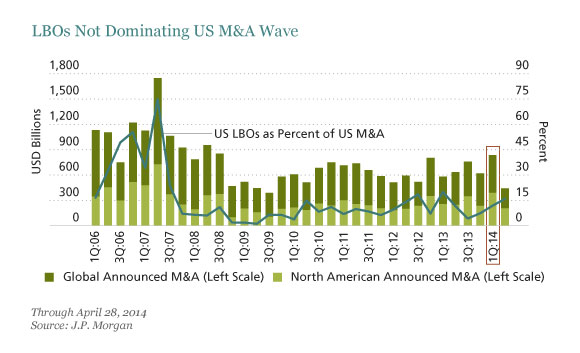This year’s leveraged buyouts (LBOs) are being financed with more debt and include fewer protections for creditors. Regulators, the press and market participants are watching this closely, and so are we. But we don’t think it’s worth losing sleep over—at least not yet.
Investors shouldn’t throw caution to the wind when dealing with LBOs. About 40% of the deals this year have involved debt financing that exceeded six times the target firm’s earnings before interest, taxes, depreciation and amortization, according to S&P Capital IQ. That’s a seven-year high. And when LBOs go wrong, it usually results in losses for creditors—and can portend trouble in the broader high-yield market.
That said, a few things make us think we’re still at least a couple of years away from a significant rise in default rates.
LBO activity isn’t widespread yet. The volume of mergers and acquisitions (M&A) has soared this year, but LBO activity—the riskiest sort of take-over—remains constrained. The total value of US take-overs swelled to $389 billion in the first quarter—also a seven-year high. But only 12% of those deals were LBOs. During the last LBO boom, in 2006 and 2007, LBOs on average made up 37% of US take-overs (Display).

Private equity is keeping its powder dry. Usually, the sort of cheap, no-strings financing that’s being offered today stirs the animal spirits of private equity firms. Aggressive debt-fueled take-overs soar and, when the economy slows, defaults rise.
This credit cycle is different. Many private equity firms underwent near-death experiences in 2009 as the last LBO boom went bust. They’re showing more restraint this time around. They’re also not terribly confident about current revenue and growth trends for potential target companies.
Private equity’s clients are more cautious, too. During the last cycle, firms would join forces to buy large companies. But these “club deals” left investors with multiple exposures to some of the riskiest deals, something nobody wants to repeat.
Strategic buyers are driving M&A, leaving fewer LBO targets. Many companies pared down operations and shed noncore business units after the financial crisis. That limited today’s supply of suitable assets for private equity firms, which load up acquisitions with debt and rely on aggressive cost-cutting to boost their profitability.
As a result, well-capitalized investment-grade companies that can benefit from operating-cost savings, and have access to cheap financing such as cash on the balance sheet, are dominating M&A. And as data from Citi Research and Dealogic show, equity accounted for 45% of the value of the global M&A deals completed last year, the highest share since 2003. That may help explain why there’s been little negative effect on the investment-grade market
A bigger global high-yield corporate bond market can absorb more LBOs. As of last year, the high-yield market had grown to $1.5 trillion, more than double its size in 2007. What’s more, issuance of BB-rated bonds—at the top of the high-yield rating scale—has easily outpaced issuance of lower-rated bonds. In other words, risky deals haven’t increased as a percentage of the overall market and they haven’t increased overall default risk.
Of course, none of this means investors should skip their credit homework. As we’ve pointed out before, investors’ single-minded focus on higher yields has left many of them more than a bit complacent about credit-related risk. Yield spreads on high-yield bonds are tight by historical standards, and we don’t think investors are being paid enough to move into the most crowded and risky trades, such as CCC-rated “junk” bonds and leveraged loans.
In our view, investors should stay focused on strong credits with solid underwriting standards and be prepared to temper their return expectations. Why is this important? Because animal spirits and riskier buyouts will increase as the economy gains momentum, eventually leading to more defaults.
We’re not there yet. The market is entering the later stages of the credit cycle, but it will take some time to complete the last leg of the journey. Our road map clearly points to lower return prospects on all risk assets, but we still believe that high-yield debt offers reasonable income potential relative to the near-term default outlook. Investors simply have to keep their eyes on the road.
The views expressed herein do not constitute research, investment advice or trade recommendations and do not necessarily represent the views of all AllianceBernstein portfolio-management teams. Past performance of the asset classes discussed in this article does not guarantee future results.